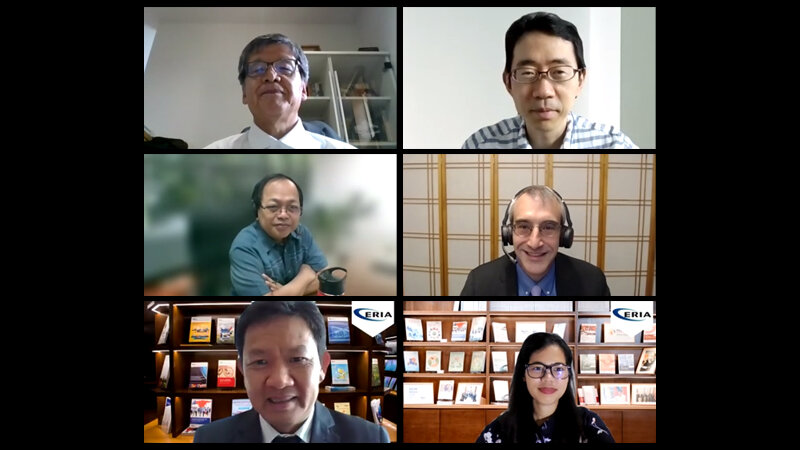The US Department of Energy Welcomes and Supports Asia CCUS Network’s Objectives
Jakarta/Washington DC, 28 July 2021: The Asia Carbon Capture, Utilisation, and Storage (CCUS) Network has full support from the US Department of Energy as Southeast Asia moves ahead in advancing the deployment of this carbon-neutral technology, CCUS. The 2nd Asia CCUS Network Knowledge Sharing Conference gathered stakeholders in Asia to share updated information on CCUS project development, regulatory framework, and the overall policy landscape under the Biden administration. The Economic Research Institute for ASEAN and East Asia (ERIA) hosted the event in partnership with the US Department of Energy on 28 July 2021. Dr Han Phoumin, Senior Energy Economist at ERIA, kicked off the conference by highlighting the US’ expertise in clean technology development that could be beneficial for ASEAN.
Director-General for Research and Policy Design Administration at ERIA, Mr Taizo Hara echoed a similar message adding that Asia can take the US’ experience in CCUS deployment to supports its regional objectives. Director, Office of Strategic Planning, Analysis, and Engagement at the US Department of Energy, Mr Jarad Daniels enthusiastically welcomed deeper collaboration between the US and Asia to further develop CCUS. Mr Daniels stated that the newly launched Asia CCUS Network will be instrumental in reaching the Asia Pacific region and is a welcome addition to the broader global CCUS community.
In his presentation, Mr Daniels informed of the Biden administration’s commitment in addressing climate change, climate mitigation, and adaptation. Based on Mr Daniels’ work, it is found that reaching net-zero targets without innovative technologies like CCUS would not be feasible hence making the technology a critical part of the overall climate change strategy. CCUS deployment is a robust part of climate solutions, particularly because a 2050 net-zero goal requires a tremendous CCUS scale-up from today’s levels. According to the Department of Energy’s findings, global society’s maximum efforts to be energy efficient will only help reach a third of the carbon emission reduction and mitigation goals between now and 2050.
In the US, steps towards carbon neutrality have garnered strong bipartisan support from Republicans and Democrats as evident through the Consolidated Appropriations Act. The law provides funding and programmes on all CCUS technologies and explores other technologies that can be integrated with CCUS such as blue hydrogen, commercialising carbon, and carbon dioxide (CO2) utilisation. The ‘Section 45Q Tax Credits’ is another measure taken by the US government to tackle the climate crisis. It is a tax benefit scheme that has been in place since 2008 though the tax provisions were increased in 2018 in a bid to incentivise industries to strengthen their green energy programmes. Through this scheme, the US currently has 36 projects in various stages of planning that are being pursued on a commercial basis and has inspired state-level incentives such as California’s Low Carbon Fuel Standard. As such, Mr Daniels shared the significance of efficient national and sub-national policy tools to ensure a successful CCUS business model.
The US’ decades-long journey in initiating a solution to climate change has resulted in several lessons for Asia and Southeast Asia’s reference. Among them is the necessity for governments to implement strong, transparent environmental regulations to support CCUS because regulatory complications at the national level can limit CCUS deployment. Mr Daniels further emphasised the importance of research and development work in progressing CCUS development in which the US spends nearly $100 million per annum on advancing carbon storage. It is also imperative for governments to engage with local communities and organisations to establish a partnership network that is integral to CCUS projects. Mr Daniels underscored the need to ensure a correct lifecycle analysis as it is used to guide discussions on the right carbon reduction initiatives for individual countries. With a wealth of experience and expertise, the US Department of Energy has numerous knowledge-sharing products which can be accessed by Southeast Asia’s CCUS stakeholders.
After the presentation, Mr Jesus Tamang, Director, Energy Policy and Planning Bureau at the Department of Energy of the Philippines commented on several key points, highlighting how the US’ application of CCUS demonstrates its capability as a decarbonisation solution. However, the Philippines has yet to implement this low carbon innovation, justifying on grounds of economic viability and level of emissions. Mr Tamang maintained that CCUS will be included in the Philippines’ energy transition strategy, hence the government is looking forward to assessing the feasibility of the technology.
Joined by Mr Daniels during the question-and-answer session, Mr Tamang inquired about the standard and certification of CCUS, and its effectiveness in reducing emissions in ASEAN given the different national conditions to that of advanced nations like the US. Mr Daniels explained that the number of ongoing CCUS projects globally should serve as reassurance over carbon capture technologies’ possibility and benefits. Nonetheless, Southeast Asia must implement clear and strong national and state regulatory policies to create an integrated system with best practices. To garner support for CCUS development, the region will additionally need to guarantee the surety of long-term storage in the subsurface to minimise safety risks such as a CO2 leak.
Acknowledging the differences between Southeast Asia and the US, Mr Daniels stated that ASEAN policymakers and industries must find a business model that works in accordance with its specific conditions and landscape. Mr Daniels also stressed that CCUS is not the sole carbon-neutral technology available as nuclear generation is another option, but what is more imperative is to have various resources work in parallel to meet the global goal of net-zero emissions.
The conference concluded with Closing Remarks by Mr Shigeru Kimura, Special Advisor to the President on Energy Affairs at ERIA who reasserted the importance of transparent regulations in promoting CCUS technology and CO2 storage. As a region with specific conditions, ASEAN will need to tailor its CCUS-supporting regulations though it should find reassurance in the US’ readiness to assist the region as it moves forward in expanding the carbon-neutral technology.

